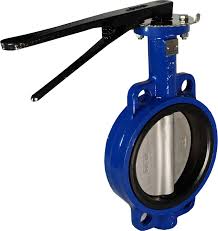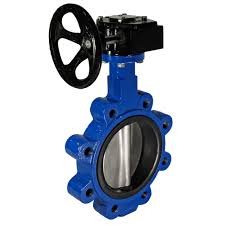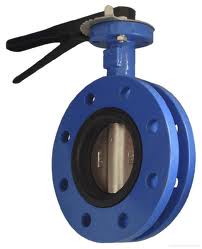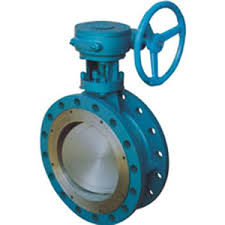A butterfly valve, abbreviated as BTFLV, is a quarter turn valve (90° or less) with a circular disk as its closing element. The standard design has the valve stem running through the disk, giving a symmetrical appearance. Other designs offset the stem. Advantages include less wear and tear on the disk and seats, and tighter shut-off capabilities. When space is limited, sometimes larger valves may use a hand wheel with a gear arrangement. Butterfly valves are rather easy to maintain. These valves are used for gases, liquids, slurries, powders, and vacuum.
There are Two Butterfly Valve Categories
Category A - Manufacturer's rated cold working pressure (CWP) butterfly valves, usually with a concentric disc and seat configuration. Sizes covered are NPS 2 to NPS 48 for valves having ASME Class 125 or Class 150 flange bolting patterns.
Category B - Pressure-temperature rated butterfly valves that have an offset seat and either an eccentric or a concentric disc configuration. These valves may have a seat rating less than the body rating. Sizes covered are NPS 3 to NPS 24 for Classes 150, 300, and 600.
Butterfly Valve Design Classification
Double Offset Butterfly Valve - This valve features the stem center deviated from the center of the disc and valve. With this structure, the valve disc can leave the valve seat quickly, greatly reducing unnecessary over compression and scraping between them. This structure also helps decrease the wearing process and prolongs the operational life of the valve.
Fire Tight Valve - When using valves in a service that may provide fuel to a fire, it is important to ensure that they are fire tight. Typically the seat in a soft seated fire tight valve contains a metal strip that will provide additional sealing should the seat be burnt or melted away. Fire tight valves can be found on fuel gas applications, VRU systems and in other flammable systems.
Flange Style Butterfly Valve - A butterfly valve with a flange on each end. These have a larger face to face dimension than the wafer and lug style butterfly valves and should not be used when there is limited space. These valves connect directly to the flanges by means of machine bolt to each side of the valve. If the valve torque is high or valve operations become too frequen, a manual flanged butterfly valves can be automated if need be.
High Performance Butterfly Valve - A valve in which the stem is not collinear to the disc centerline but rather offset from the center. The use of offset design helps to enhance uniform tight shut-off against the valve seat and also reduce wear due to friction. This valve can be used for shut-off and throttling fluid flow applications. This valve is made to handle different fluids from general fluid flow applications to viscous and corrosive fluids. The corrosive fluids can be gases or steam. High-performance butterfly valves are mostly of large sizes like 60 inch diameter.
Lug Style Butterfly Valve - Lug butterfly valves connect directly to the
flanges by means of a lug or machine bolt. Since these are attached directly to the flanges, each length of pipe on either side of hte valve can be removed and replaced independant of the other.
Unlike a wafer type butterfly valve, a lug style valve can serve as an end of the line valve. Lug style butterfly valves have the same face to face dimensions as a wafer style butterfly valve. The valves can be used for end of line service but a blind flange is always recommended. The valves are manufactured to be compatible with either pneumatic or electric actuation.
Triple Offset Butterfly Valve - The design eliminates the rubbing between the seat and seal ring through the flow path, reducing seat and seal wear and extending cycle life. They are used in applications similar to gate valves, where a metal seat is required, and tight shutoff and/or quarter-turn actuation is desired. Triple offset butterfly valves can open and close more quickly and can be frequently operated, even if there is an emergency shutoff. This valve has low torque and is recommended for both high and low
temperature applications.
Wafer Style Butterfly Valve - Most wafer style butterfly valves are engineered with four holes that align with the connected pipeline. The valve is sandwiched between two flanges. The rubber valve seat creates a strong seal between the valve and flange connection. Unlike lug style butterfly valves, wafer style butterfly valves cannot be used as pipe ends or end of line service. The entire line must be shut down if either side of the valve requires maintenance. Wafer style butterfly valves are manufactured to be compatible with either pneumatic or electric actuation. Disc and seat material should be determined based on application and flow media.
Zero Offset Butterfly Valve - Concentric or rubber seated are other names for the zero-offset design. Zero offset means there is no offset by the stem of the valve. The valve seals via interference along the disc edge at the stem between the disc and the rubber seat.
Butterfly Valve Advantages and Disadvantages
|
|---|
| Advantages | Disadvantages |
|---|
- Easy to install.
- The installation costs are low.
- Simple structure, small volume and light weight.
- The opening and closing time is short and the flow resistance is small.
- The opening and closing torque is small, because the butterfly plates on both sides of the rotating shaft are basically equal to each other under the action of medium, and the direction of torque is opposite, so it is easier to open and close.
- When the valve seat is fully open, the effective flow area of the valve seat channel is large and the fluid resistance is small.
- The sealing surface materials are generally rubber and plastic, so the low-pressure sealing performance is good.
- It can be used for media with suspended solid particles, and can also be used for powdery and granular media, depending on the strength of the sealing surface.
- It can be applied to the two-way opening and closing and adjustment of ventilation and dust removal pipelines.
- Widely used in pipelines, waterways, light industry, and petrochemical systems.
- Butterfly valves can transfer mud with a little fluid deposit in the outlet of the pipe.
|
- The flow adjustment range is small. When the opening is up to 30%, the flow rate will be nearly 95% or more.
- Due to the limitation of the structure and the sealing material, butterfly valve is not suitable for use in high temperature and pressure piping systems.
- The sealing performance is relatively poor compared to ball valves and globe valves, so it is not used for sealing requirements.
- Prone to cavitation at lower flows.
- When butterfly valves are used, throttling is limited to low pressure drop systems.
- A part of the butterfly disc is always facing the flow, even if it’s completely open.
|
Butterfly Valve Datasheets
Face to face dimensions for full and standard port valves is the same. All ball valves 2" and below are both standard and full port valves. |
   |
- Butterfly Valves, Wafer, Lug, Flange
|
 |
- Butterfly Valves, Triple-offset
|







